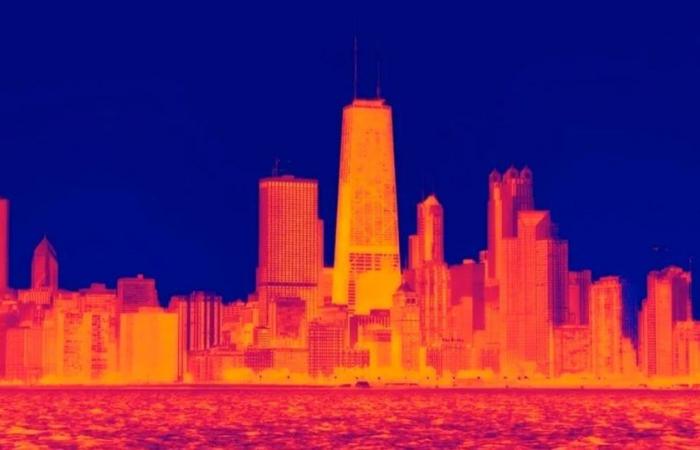A study conducted by the POT warns of the possible devastating consequences of global warming: Some areas of the planet could become uninhabitable by 2050. Based on satellite dataThe report focuses on rising temperatures and humidity, using the wet bulb index to identify and assess the regions at greatest risk. This index is crucial, as a temperature above 35°C (95°F) for six consecutive hours can be lethal by preventing the human body from regulating its temperature.
The POT warns that the heat waves are becoming more frequent and intense in response to global warming, with serious repercussions on human health. A key indicator of this situation is the thermal stress index, which warns of potentially dangerous conditions.
Colin Raymondfrom the Jet Propulsion Laboratory of the POT in Southern California, notes that extreme levels of heat stress have doubled in the last 40 years and this trend is expected to continue. Their 2020 study, published in Science Advancesdetails how wet bulb temperatures, a critical indicator, are rising around the world.
The wet bulb temperature measures the body’s ability to cool itself through evaporation of sweat. This temperature is critical, as a wet bulb above 35 degrees Celsius (95 degrees Fahrenheit) is lethal to humans if exposed to open air for at least six hours. Since 2005, wet bulb temperatures above 35 degrees Celsius have been recorded on nine occasions in subtropical locations such as Pakistan and the Persian Gulf, according to POT.
Recent heat waves, such as the one that hit the northwestern US last summer, are examples of this dangerous trend. Hundreds of people died in that case due to high temperatures, underscoring the severity of the effects of extreme heat.
The heat index, commonly known as apparent temperature, is used in daily weather bulletins. This index combines temperature and relative humidity to indicate what the weather actually feels like to the human body. However, it is a subjective measure and varies between countries. Therefore, scientists are increasingly turning to wet-bulb temperature measurements for global climate studies.
The number of days with wet bulb temperatures between 32 and 35 degrees Celsius (90 to 95 degrees Fahrenheit) has tripled in the past 40 years, according to the study by Raymond. “Once the wet bulb temperature exceeds 35 degrees Celsius, no amount of sweating or adaptive behavior is sufficient to lower body temperature to a safe level,” Raymond said in his study.
The impact of extreme heat is not limited to one specific location. NOAA Statistics They point out that heat is the leading cause of weather-related deaths in the US during the period from 1991 to 2020. Raymond He adds: “Even when wet bulb temperatures are considerably lower, people can still succumb to heat stress, as happened during the Pacific Northwest heat wave in June 2021, when wet bulb temperatures were close to 25 degrees Celsius (77 degrees Fahrenheit).”
The people Those most vulnerable to high wet bulb temperatures include the elderly, outdoor workers, and those with underlying health conditions. Those without access to air conditioning are also at higher risk. This equipment is crucial in extreme humidity conditions as it removes moisture from the air. This is explained by Raymond: “In humid regions, once wet bulb temperatures reach between 34 and 36 degrees Celsius (93 to 97 degrees Fahrenheit), no matter what you do, you cannot survive for extended periods.”
Institutions like NOAA are developing more advanced metrics to measure thermal stress, such as global wet bulb temperature (WBGT). This measurement considers not only temperature and humidity, but also wind speed, sun angle, and cloud cover. However, the standard for long-term climate research remains the wet bulb temperature.
Most locations with extreme wet bulb temperatures are in developing countries in the subtropicswhere reliable weather stations are scarce. NASA satellites like the sensor Atmospheric Infrared Sound (AIRS) on the satellite Aqua and the experiment Thermal Radiometry of Ecosystems in Space (ECOSTRESS) on the International Space Station provide valuable data for identifying hotspots and studying extreme heat events. These data feed computer models that allow for detailed analysis of temperature and humidity in different regions.
Raymond predicts that certain areas could face wet bulb temperatures above 35 degrees Celsius between 2040 and 2070, the results of the study revealed that the South of Asiaincluding countries like Pakistan, could be one of the most affected regions. In recent decades, some subtropical areas have already exceeded this critical threshold, suggesting that the phenomenon will worsen in the near future.
He Persian Gulf This is another of the critical points mentioned in the study. Extreme temperatures and high levels of humidity could make this area uninhabitable.The Persian Gulf already facing extreme conditions, and The future does not look promising if urgent measures are not implemented“, NASA experts stressed.
Another focus of attention is the Red Sea. Coastal areas in this region are also at risk due to rising temperatures. The wet bulb index in this area is projected to exceed the tolerable limit for human life, which represents a serious problem for local communities.Global warming is gradually transforming these regions into inhospitable environments for humans.“, the scientists noted.
In Brazil, certain regions are also expected to face uninhabitable conditions by 2070. The increase in temperatures and humidity in these places could reach dangerous levels, experts warn. “He global warming will have a devastating impact in various parts of the world, and Brazil is not exempt,” the report says.
He eastern china It is also on the list of areas at risk. This region could experience wet bulb indices above 35°C (95°F), endangering the health and lives of its inhabitants. “The projections are alarmingthe situation must be closely monitored and immediate action must be taken to mitigate these effects,” the scientists warn.
In the US, Midwestern states such as Arkansas, Missouri and Iowa could reach these critical limits within the next 50 years. With input from scientists and government agencies, it is imperative to recognize and prepare for the growing threats of extreme heat as climate change rapidly intensifies.






